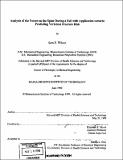Analysis of the forces on the spine during a fall with applications towards predicting vertebral fracture risk
Author(s)
Wilson, Sara E. (Sara Ellen)
DownloadFull printable version (6.575Mb)
Alternative title
Assessment of forces on the thoracolumbar spine during a fall with applications towards predicting vertebral fracture risk
Other Contributors
Harvard University--MIT Division of Health Sciences and Technology.
Advisor
Elizabeth R. Myers.
Terms of use
Metadata
Show full item recordAbstract
Age-related vertebral fractures are a common public health problem for the elderly with an estimated 27 percent of U.S. women aged 65 years and over thought to have at least one vertebral fracture. It is important, therefore, to characterize the "at risk" patient and to find methods of reducing that risk. Fracture risk has been defined as the ratio of applied loads to the force required to fracture a bone. Although studies have examined the force required to fracture, few studies have tried to assess the applied loads associated with fractures. Epidemiological studies have found that as many as 30 to 50 percent of vertebral fractures are associated with falls. This work examines the forces on the spine during a backward fall. Models of a passive fall, without tension in the torso musculature, were constructed in order to examine the peak axial forces on the spine as a result of a passive fall. Muscle tension elements were added to examine the effect of pre-compression of the spine by the musculature. Three experimental and observational studies were performed to examine the input parameters of these models. This included an experimental measurement of the stiffness and damping of the spine segments, measurement and modeling of the fall dynamics in a backward fall, and measurement of the geometry of the torso musculature. The peak axial forces on the spine were found to range from 1100 Newtons to 3500 Newtons depending on a number of factors including the fall impact dynamics (fall velocity and torso angle), the body weight of the individual, the properties of the soft tissue of the pelvis and spine, and the amount of muscle tension in the torso musculature. These forces can be compared to a mean compressive failure force around 2000 N in elderly thoracolumbar vertebrae. This puts a portion of the elderly population at risk for a fracture simply from an upright passive fall of average velocity. The highest forces were found in upright, fast falls in which the individual had a high upper body weight and very tense torso musculature and little damping in the spine.
Description
Thesis (Ph.D.)--Harvard--Massachusetts Institute of Technology Division of Health Sciences and Technology, 1999. Includes bibliographical references.
Date issued
1999Department
Harvard University--MIT Division of Health Sciences and TechnologyPublisher
Massachusetts Institute of Technology
Keywords
Harvard University--MIT Division of Health Sciences and Technology.